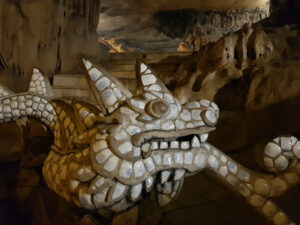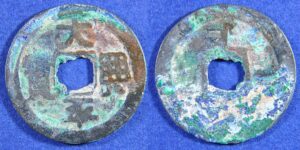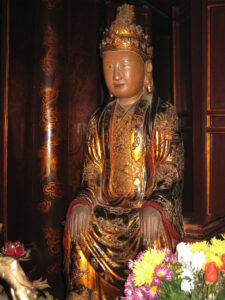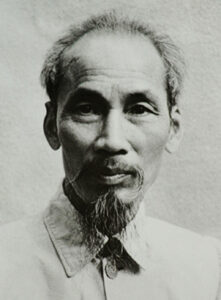The first recorded name given to the country we now call Vietnam was Xích Quỷ (2879–2524 BC). This ancient era is one of myths and legends and oral histories passed down over millennia. Very little can be confirmed or denied bar the name and that it was perhaps 10x larger in area than the modern Vietnamese border. A the time, China itself was little more than a collection of rival clans and feudal lords.
The people of the area in that time were anecdotally known as “Bách Việt” – the southern people – by the warring Chinese states to the north.
Van Lang
Around 2525, Van Lang, a land ruled by the Hung Kings, gained ascendancy. In myth and legend, Kinh Dương Vương (2919–2792 BC) was the first “king” of the Vietnamese people and is credited with a son named Lac Long Quan. According to the legend, this son took a wife named Au Co who subsequently gave birth to 100 sons, 50 of who followed their father to the east coast while the remaining 50 went with their mother to the Western mountains. When the eldest son of Au Co grew up, he took the title Hung Vuong (King Hung), named the country Van Lang and based its capital in Bach Hac in Phu Tho Province.
Although verified records of this period are thin on the ground, the Van Lang period is said to have lasted from 2879 to 258 BC and developed a high level of bronze casting. The most famous remains of this period are the so called Đông Sơn Bronze Drums, large kettle drums molded with intricate designs depicting various motifs of everyday life at the time. These motifs have become the foundation of most of the present day knowledge of the housing, clothing, customs, habits, and cultural activities of the Hùng era.
Au Lac/ Nam Viet
In 257 BC the historically verified personage of Thuc Phan defeated the 18th Hung King, took the title An Dương Vương and established the Kingdom of Âu Lạc. This is the first documented state of ancient Vietnam, uniting the Âu (mountain) and Lạc (coastal) clans as one people. However, shortly after in 218 BC, the Chinese emperor Qin Shi Huang of the Qin Dynasty ordered an invasion of Âu Lạc and sent 30,000 troops to that aim. In a war lasting almost 10 years, the invading force was destroyed. This is the first verified resistance war in recorded Vietnamese history.
However, the victory was short lived, ending in 208 BC when An Dương Vương was defeated by Trieu Da, a Qin mandarin from Guangdong in southern China. Au Lac was renamed Nanyue (Nam Viet) and became a vassal state of the early Chinese Han Dynasty.
The history of much of the following millennia is of occupation by a succession of warlords from the North and the Âu Lạc people began a long turbulent period of Chinese domination. Called the Northern Reign or Giao Chỉ (aka Jiaozhi), the Vietnamese did not take easy to being a vassal state and there were many civil wars and insurrections. After centuries of unrest, in 968 AD a new king overthrew the Chinese and proclaim a new independent Vietnamese kingdom of Đại Cồ Việt, believed by many as the direct precursor of the modern Vietnam state.
Dinh and Le Dynastys
The Dinh dynasty (968-980) and the first emperor Đinh Bộ Lĩnh (aka Đinh Tiên Hoàng aka Đinh Hoàn) lasted just 16 years but changed Vietnamese history forever. The Đinh dynasty through its King laid the foundations of a centralized Vietnamese society, achieving the long sought recognition as an independent country from the rulers to the North (China). Close to Đinh Tiên Hoàng home in present day Ninh Binh, Hoa Lư became the capital of this new state.
It’s important to remember the context and the fact that the political and cultural landscape of the world at that time. Comparing it to other contemporary events and developments in different parts of the world is perhaps useful for a better understanding of the historical context.
China In 1000 AD, was not organized in the way it is today but rather a collection of various kings and warlords paying tribute to a central dynasty, each with their own agenda. Elsewhere, this was the time of the Viking invasions of England, the completion of the Buddhist temple complex of Borobudur in Java, the construction of Al-Azhar University in Egypt, and the founding of the Angkor Dynasty in Cambodia by Jayavarman II, the legendary Khmer Emperor.
Đại Cồ Việt
In 968 King Đinh Bộ Lĩnh renamed the kingdom Đại Cồ Việt. Đại roughly translates as “Great” while Cồ is Chinese terminology of the same. Using characters from both languages, the King believed that the country would then be interpreted as “the Great People of Viet” regardless of local or foreign languages.
The Dinh Dynasty was succeeded by the Early Le dynasty (980-1009) who remained loyal to the ideals of the Dinh Dynasty. Indeed, after King Dinh’s untimely death by assassination, his wife, the Empress Dowager Dương Vân Nga married the ascendant Lê Hoàn, the former commander-in-chief of Đinh Bộ Lĩnh’s army and founder of the transient Le Dynasty. In time, the pair negotiated a peaceful transfer of power to the ascendant Ly Dynasty (1009-1225).
King Lý Thái Tổ, the first king of the Lý Dynasty, agreed that the rugged and narrow terrain of Văn Lãng-Hoa Lư provided excellent strategic advantages against foreign invaders. However, as the Chinese threat grew more distant and Đại Cồ Việt prospered, he desired a larger, more arable area with enough space to grow the ascendant empire.
Lý Dynasty
In 1010 the capitol of the Lý Dynasty was moved 100km north to the wide flat alluvial plains of the Red River. Although traditionally the land was refered to as Au Lac, King Lý Thái Tổ, renamed the area to Thăng Long. Dependent on who you ask, this translates to either “Rising Dragon” or “Flying Dragon” – both of which proving a prophetic name if there ever was one.Today Lý Thái Tổ’s contribution to modern Vietnamese history is marked by the Đại La citadel in Hanoi, the modern name of the northern capital of Thăng Long.
Destroyed and rebuilt several times over the following centuries, you can still visit the reconstructed Citadel at 18 Hoàng Diệu Street in Hanoi. Renovated and restored, the complex now houses a considerable amount of artifacts from Vietnamese history and it is a must see for anyone interested in the history of this vibrant land.
The third Lý emperor, Lý Thánh Tông (1054–1072) is credited as shortening the country’s name to Đại Việt. It still meant the “Great People” but by dropping the Chinese “Cồ” character, many believe this signified end of concern over future Chinese colonialism. The name Đại Việt would continue to be used for some 800 years until the rise of the Nguyễn Dynasty of Hue and the advent of French colonialism.
Trần Dynasty
The Trần Dynasty succeed the Lý and ruled over the Kingdom from 1225 to 1400, renaming Hoa Lư to Trường Yên. In the 10th year of Quang Thái (1398), the Trần Thuận Tông dynasty changed it once again – this time to Thiên Quan.
It should be noted that one of the challenges for those studying Vietnamese history is the frequent changes in names – places, people, dynasties and deities often have multiple titles that are closely linked to specific periods and events. There is no simple solution to this issue, but it is an inherent part of the dynamic and tumultuous history of this resilient and captivating country.
Like much of world history during the period, there was still considerable political turmoil and persistent warfare but the new land of Đại Việt was here to stay – with or without Chinese consent. A land rich in agriculture and minerals and numerous deep water ports, it was also an important strategic asset keenly sought by many of the surrounding nations. During the Yuan Dynasty (1271 -1368) in China, there were many attempts by the Mongol kings to invade Đại Việt. Perhaps the most famous battle was at Bạch Đằng River, where the Yuan Navy were decimated and were forced to retreat by the irrepressible Vietnamese warriors.
The Fall of the Trần
The Trần dynasty lasted from 1226-to 1400, when General Ho Quy Ly (1336-1407) usurped the throne to become king and renamed Đại Việt to Đại Ngu, meaning (Great Joy / Peace). Taking advantage of the internal strife, the Ming Dynasty attacked and finally managed to conquer the land, albeit only for twenty short years (1407-1427).
Le Loi, a wealthy landowner from Lam Sơn in Thanh Hóa, began a resistance movement against these newest invaders around 1418, eventually forcing the Ming to retreat back to China after a 10 year struggle. Le Loi, who to this day is celebrated as a national hero, declared himself emperor using the name of Lê Thái Tổ and founded the fourth Vietnamese dynasty of the Later Lê.
After this brief reminder of the expansive nature of its much larger northern neighbor, the rulers of the Đại Việt themselves became conquerors. Subsequent Dynasties of the Later Lê (1428–1789); the Mạc dynasty (1527–1677); and the brief Tây Sơn dynasty (1778–1802) continued to expand the Đại Việt nation to what basically is now the current borders of modern Vietnam.
Later Lê Dynasty
The Later Lê, like the early Trần kings, began a period of renaissance of Vietnamese art, architecture, legal reforms and a huge expansion of the Đại Việt borders. Large parts of Champa (Cambodia) were annexed and settlements in Da Nang, Nha Trang and the Mekong Valley were formed. But all things pass and, beginning in 1528, the power of the Later Lê Dynasty began to wan and the Mạc and Trịnh families competed for control of the north while the emergent Nguyễn family rose in power in the central and southern regions.
Nguyễn Dynasty
The last Đại Việt empire was the southern Nguyễn Dynasty (Thời Nhà Nguyễn) who ruled during the period 1802-1945 and renamed Đại Việt to Viet Nam. With French help, Lord Nguyễn Phúc Ánh took the strategically important Phu Xuan in 1801 and the northern Tây Sơn capitol of Thăng Long (Hanoi) a year later. With the Tây Sơn defeated, Nguyễn Anh proclaimed himself Emperor Gia Long.
The Nguyễn Dynasty’s actions in bringing in the French, who had previously failed to establish a colony in Vietnam, still generates some controversy in Vietnam over whether without the Nguyễn dynasty’s alliance with France, the French could ever have gained a foothold into Vietnam..
Under the rule of the Nguyễn Dynasty, the capitol of Vietnam moved from Thăng Long to their ancestral home in Hue city, far to the south. The Nguyễn Dynasty, like the Qing Dynasty in China in the same time frame, was said to have been both arrogant and dissolute, propped up by French military forces and reverting to almost feudal rule. While no expense was spared supporting the arts and building the magnificent but ultimately ill-fated palace in Hue, villages were impoverished and the people were often in open revolt.
French Colonialism
With local government in disarray and the French superiority in ships and arms, the colonialists realized their advantage and between 1859 and 1883 all of Vietnam fell to French control. The Nguyễn Dynasty became little more than a puppet of Paris as French forces expanded their influence to the North, the South and across the western borders with Laos and Cambodia. Viet Nam was divided into three separate areas – the protectorates of Tonkin (including Ninh Binh and Thăng Long) to the north, Annam in the central area and Cochin China to the south. This roughly is emulated by the current borders between North Vietnam, Central Vietnam and South Vietnam.
Cambodia and Laos also fell under a French Protectorate and together with Vietnam, for the next 60 years became known as French Indochine. The French brought many benefits to the region, especially in agriculture, education and architecture. However, they also brought in many onerous and repressive laws and allowed many Chinese traders and workers to flourish freely, often to the detriment of the local populace.
Discontent with the French was already simmering when World War 2 disturbed the balance of power across all of Asia. In 1945 the newly formed government in Hanoi declared independence from both the French and the occupying Japanese forces in what is known in Vietnam as the “August Revolution”
Modern Vietnam
The period between 1945 and 1975 saw Vietnam fighting for its freedom from both colonialists and foreign invaders. This period has been covered extensively elsewhere so sufficient to say that it culminated with the withdrawal of both French and American troops and an independent Viet Nam.
Led by Hồ Chí Minh’s Việt Minh, the new government rejected any thought of a return to the feudal dynasties. Instead, the country was organized into a central government with numerous provincial adjuncts. Many existing provinces and cities were re-named after famous Vietnamese heroes and significant historical events and for a short period Ninh Binh once again became known as Hoa Lư province. However, there was internal dissent with this ruling. Only a few months later the new Central Government Council decided that the provinces should retain their popular names and Hoa Lư once again became Ninh Binh.
For many current Vietnamese, there is no great rancor against the French and American forces. Mostly they are seen as just failed foreign invaders once again successfully repelled from a country that values independence and freedom above all else.
The Return of Ninh Binh
As mentioned earlier, the Tran Dynasty renamed Hoa Lư to Trường Yến in the early 13th Century. In 1398, the Tran Thuan Tong dynasty changed it once again – this time to Thiên Quan.
In the third year of the reign of King Minh Mang of the Nguyễn Dynasty (1822), the name of Thanh Bình region (where Hoa Lư is located) was changed to Ninh Binh. Although it remained a region within Thanh Hóa province, it was officially designated as the Ninh Binh state during the 10th year of King Minh Mang’s reign (1829), the beginnings of the modern province we know it today.
Over a century later in 1976, Ninh Binh was merged with nearby Ha Nam province renamed to the Hà Nam-Ninh Province.
The 8th National Assembly of the 10th session made the decision to separate Ninh Binh and Hà Nam Ninh into two provinces in December 1991. The statehood of Ninh Binh was restored, and it was divided into seven administrative units, including Ninh Binh City, Tam Điệp City, and five rural districts: Hoàng Long, Hoa Lư, Gia Viễn, Tam Điệp, and Kim Sơn.
Please remember this is a short history. The full unexpurgated version would take many years and tomes to fully explore. However, hopefully we have encapsulated a small part of what ultimately is a remarkable and exceeding complex national history.






